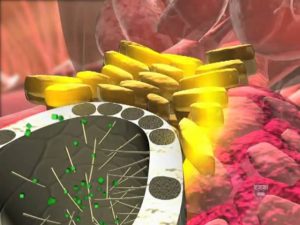Developed and produced by http://www.MechanismsinMedicine.com Animation Description: This animation represents a visual interpretation of the production of testosterone and is not indicative of clinical effectiveness. The hypothalamus releases gonadotropin-releasing hormone (GnRH) in pulses every 60 to 90 minutes to stimulate the pulsatile release of luteinizing hormone (LH) from the pituitary gland into the bloodstream. LH binds the LH receptor on the Leydig cells of the testes. Binding initiates a cascade of events which include the conversion of cholesterol (depicted as LDL here) to pregnenolone followed by a series of reactions, which convert pregnenolone to testosterone. Testosterone, secreted by the testes, diffuses into the peripheral circulation to be carried to target tissues. In liver, muscle and adipose tissue, testosterone binds directly to its androgen receptor (AR) to exert its biological effect. In skin, hair, the prostate gland and gonadal tissue, testosterone must be converted to dihydrotestosterone (DHT) by 5-alpha-reductase in order to bind the androgen receptor. In bone and brain, testosterone is converted by aromatization to estradiol (E2), which binds the estrogen receptor (E2R) to carry out its effects. There is an accompanying accredited online resource, http://www.ManagingTD.ca that contains the learning materials, as well as videos, animations & an interactive algorithm.

Testosterone Production
- Post author:
- Post published:May 5, 2021
- Post comments:0 Comments
You Might Also Like

Aromatic Oils Video – 1

what is renal failure / Symptoms of kidney failure / chronic & acute kidney failure

Heart Attack-What Can Cause a Heart To Stop Beating?

What is the Difference Between Food-grade and Pharmaceutical-grade Products/Supplements?

The Best Aerobic Exercise for Arthritis – The Basic Jog

Examples of Low-Impact Aerobic Exercises : General Fitness Tips

Pulmonology Video – 1

Understanding Type 2 Diabetes

Girl’s BEST Abdominal Exercises: Leg Raises

Causes and prevention of High Blood Pressure in young people – Dr. Surekha Tiwari

Organ Transplantation Surgeries Video – 3

OUTER Bicep Split | Seated Dumbbell Curls| Rob Riches

DNA replication – 3D

What Is Acne?

The Best Protein Powders – Our Favorite Whey Options (NOW!)

How to Use the Back Extension Machine for the Obliques : Shaping Up

Chapter 11 propranolol

Trying to Get Into Fitness & Health

Menopause Nutrition Video 1

How To: Close-Grip Barbell Bench Press
Sports & Recreation

Seated & Standing Calf Presses

Water Polo Video – 1

How to Do a Hammer Curl | Female Bodybuilding

How to Do a Proper Squat

BODYBULDING MOTIVATION 2017 | ONE LAST REP |

Neurological Physiotherapy Video – 8

How many EGG WHITES a day are SAFE | Info by Guru Mann

Alternating hammer curls (standing with dumbbells)

Shiatsu Video – 2

Decline Bench Press : Chest Exercises

Front & Lateral Raise Combo : Best Shoulder Exercises

Water Changes Everything.

High Intensity Training Video – 5

Kidney animations

Bent Over Row Demonstration

How To: Seated Low Row (LF Cable)

4 Proven Benefits of BCAAs (Branched-Chain Amino Acids)

The Truth about BCAAs…

Isotretinoin-Induced Acne Fulminans

Muscleblaze Weight Gainer Review || Gain weight fast

